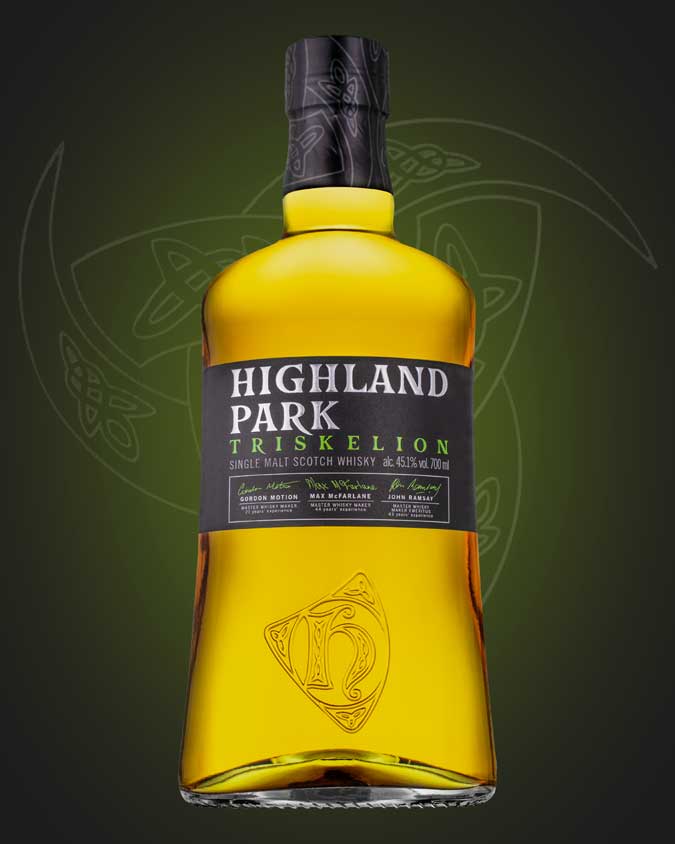 THE TRISKELION is an ancient symbol with some of its earliest uses detected in artifacts from the Bronze Age. The Triskelion single-malt from Highland Park takes its cues from the symbol’s usage in Norse mythology, the horn triskelion that kept the Norse gods’ Mead of Poetry (a few drops spilled out for the mortals). The triple-horned symbol extends to the collaboration between Master Whisky Makers of Highland Park: incumbent Gordon Motion, and his predecessors, Max McFarlane and John Ramsay. “Between us, we have 100 years of experience,” said Mr. Motion in a video played during a Zoom tasting last week.
THE TRISKELION is an ancient symbol with some of its earliest uses detected in artifacts from the Bronze Age. The Triskelion single-malt from Highland Park takes its cues from the symbol’s usage in Norse mythology, the horn triskelion that kept the Norse gods’ Mead of Poetry (a few drops spilled out for the mortals). The triple-horned symbol extends to the collaboration between Master Whisky Makers of Highland Park: incumbent Gordon Motion, and his predecessors, Max McFarlane and John Ramsay. “Between us, we have 100 years of experience,” said Mr. Motion in a video played during a Zoom tasting last week.
Adrian Tecson, Highland Park Brand Advocate, told the saga of Highland Park. The brand, now owned by the Edrington Group (behind the Famous Grouse and The Macallan) was named after a hill in the Orkney Islands where its founder, Magnus Eunson, made whisky under the cover of night back in 1798 for the pleasure of pirates. Mr. Eunson, a butcher and a church officer by trade, hid whisky in the church he served. He later had to legalize and standardize his operations after being caught by authorities about 30 years after.
The distillery is Scotland’s sixth-oldest, and has the distinction of being the world’s northernmost single malt Scotch whisky distillery. It’s only in Scotland by a technicality: the islands themselves once belonged to Norway, settled as they were by Vikings. The islands reverted to Scottish rule when they were included in the dowry of Princess Margaret of Denmark when she married King James III of Scotland in 1472.
Mr. Tecson further explained how everything extraordinary about Orkney contributes to the whiskies. Receiving the warm Gulf Stream winds, it has a winter low of 2 degrees celsius. “It doesn’t snow that much there,” said Mr. Tecson, while pointing out its northern latitude. “This climate is perfect for a long and even-phased aging and maturation — there are no extreme temperatures to affect the condition of our casks.” The casks used for the Triskelion include first-fill sherry seasoned Spanish oak butts, first-fill sherry seasoned American oak casks, and first-fill bourbon barrels and hogsheads.
Finally, there is the peat that flavors Highland Park’s whisky which is colored by the gentler heather that grows in the area — lending a different kind of smoke from other peated whiskies. “There is no other single-malt that tastes like Highland Park,” said Mr. Tecson.
We tried the Triskelion in a little tulip glass, noting that the scent can be detected from about a foot away. It had a scent like dry hay, grass, and wood smoke — like a morning in a farm. It’s followed by a more exotic note of oranges, a note reflected in its taste. The taste begins and ends in a puff of smoke: the peatiness is very evident, but not so much as to mask other flavors. There’s a heat that slowly smolders into a fire, but once settled, it has a strangely creamy mouthfeel. There are notes of vanilla and espresso, but there are definitely more: finding out the complex nuances can be a meditative experience while you drink it slowly — as you should, as it costs almost P17,000 a bottle. The peaty note is energizing and eye-opening, so one can take this up to the mountain house to drink while self-examining or having a late-night one on one with someone near and dear. Pairing suggestions would be dark chocolate, a creme brulee — the burnt caramel would accentuate the peat, while the rest of the dessert would soften the blow of its stronger aspects, while simultaneously highlighting its gentler notes. One can also embrace its smokiness and pair this with a cigar with a floral note.
This particular expression had won a Gold at the International Spirits Challenge in 2020, and a Gold at The Scotch Whisky Masters in the same year. “He’s a guy who knows his whisky,” Mr. Tecson said about the Triskelion drinker. “Someone who appreciates lots of layers.”
Highland Park Triskelion is available through official distributors Future Trade, Inc.’s website, futuretradeinc.com, as well as thirst.com.ph. There are only about 50 bottles in the country, each priced at P16,800. A guest lamented, “Now you tell us there are only 50 bottles left — and we just finished the sample.” — Joseph L. Garcia

